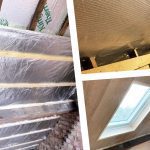The heat escaping from your home both burns money and increases your carbon footprint. If you see a heat-imaging scan, you’ll be struck that, while there are a number of hot spots, the bulk of the escaping heat comes through the roof.
It has to be stopped.
What Is Loft Insulation?
Loft insulation consists of a layer of non-conductive material that prevents heat either from getting from the top storey to the loft or from the loft to the outside. The recommended minimum thickness is 270mm, but this has increased dramatically in the past few decades. If you have old insulation, it probably won’t be enough.
If you’re simply using your loft for general storage, a “cold loft” is fine, whereas if you’re storing items sensitive to temperature changes or planning to spend time up there, you’ll need a “warm loft”. These terms are actually misleading — a cold loft can be hot in summer and cold in winter, while a warm loft’s temperature is easier to control.
Where Does Loft Insulation Go?
Basic loft insulation, which is required for either a warm or cold loft, is inserted between the joists or rafters. This may then be boarded over, but 270mm will probably come up over the joists. It’s important to raise the boards, to prevent restricting ventilation and overheating electricity cables.
For a warm loft, you also need insulating material on the underside of the roof. With a flat roof, on the other hand, the insulation will normally go on the outside of the roof.
What Is Loft Insulation Made Of?
For between the rafters, mineral wool is the most common material, since it’s cheap, effective and easy to install. Sheep wool is superior but more expensive, or for a top-up, you can use loose material like recycled newspaper. A hard-to-reach space can be filled by blown fibre, but this is a strictly professional job.
For the underside of your roof, you can buy insulating boards or reflective foil. These are more expensive than mineral wool, but they’re extremely effective.
How Does Loft Insulation Work?
Whichever material you choose should be a poor conductor of heat. This means that the heat gathering immediately below it can’t be transferred to above and is trapped in the main part of the building — the part you want warm.
Loft insulation isn’t expensive, and you’ll have recovered the cost in lower energy bills within two years. After that, it’s all profit — and that’s a great reason to insulate your loft. Contact us if you want to know more.
Was this post useful? Here are some other’s you might like...







